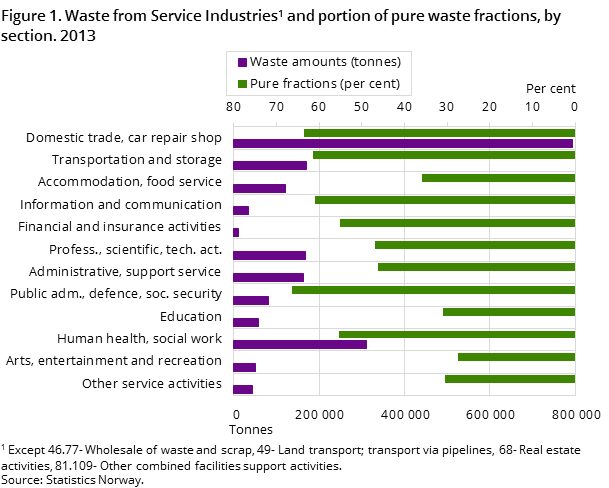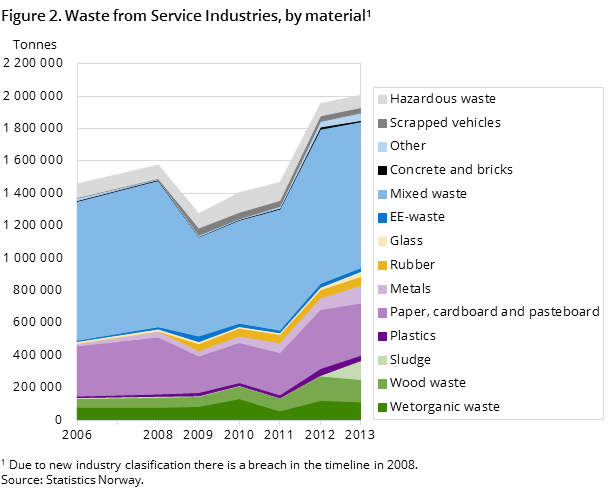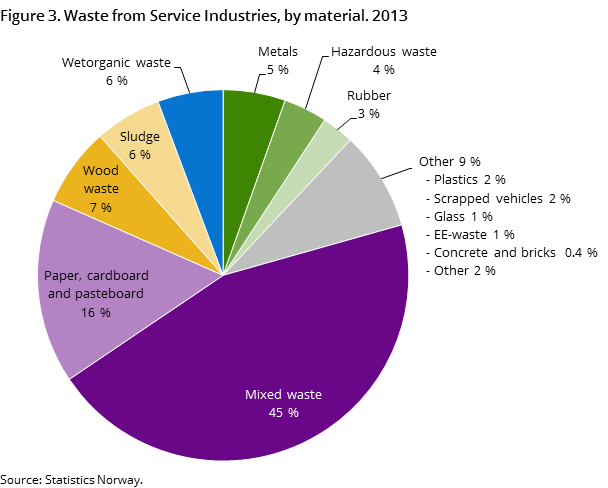Content
Published:
This is an archived release.
Small changes in waste from service industries
The service industries generated more than 2 million tonnes of waste in 2013. This is the first time that the service industries have generated more than 2 million tonnes of waste. Nearly 40 per cent of the waste originated in the domestic trade business.
| Tonnes | Per cent | Per cent | ||
|---|---|---|---|---|
| 2013 | 2012 - 2013 | 2008 - 2013 | ||
| Waste amounts by material | ||||
| In total | 2 006 996 | 100.0 | 2.7 | 27.4 |
| Mixed waste | 901 742 | 44.9 | -5.3 | -0.2 |
| Paper, cardboard and pasteboard | 322 553 | 16.1 | -11.5 | -8.2 |
| Wetorganic waste | 114 611 | 5.7 | -6.8 | 42.0 |
| Hazardous waste | 76 386 | 3.8 | 3.3 | -7.2 |
| Other materials | 591 704 | 29.5 | 34.3 | 274.5 |
| Waste by section | ||||
| In total | 2 006 996 | 100.0 | 2.7 | 27.4 |
| Wholesale and retail trade: repair of motor vehicles and motorcycles | 794 173 | 39.6 | 2.2 | 23.6 |
| Human health and social work activities | 311 954 | 15.5 | 15.0 | 55.9 |
| Administrative and support service activities | 164 405 | 8.2 | -33.1 | -3.1 |
| Other service sections | 736 464 | 36.7 | 11.6 | 30.7 |



The waste amounts from the service industries increased by just under 3 per cent from 2012 to 2013. Mixed waste is still the largest waste fraction, with 45 per cent of the total waste.
The waste amounts from the service industries have increased by 38 per cent since 2006. In comparison, the value added (fixed 2005 basic prices) for the industry increased by only 18 per cent during the same period. This implies that the industry has become less waste efficient during the last seven years.
Most waste from the domestic trade business
More than 790 000 tonnes of waste, or nearly 40 per cent, came from the domestic trade business in 2013, which is almost the same amount as in 2012. Second and third in magnitude are human health and transportation and storage, with 16 and 9 per cent of the total waste amounts respectively.
Increase in sludge, decrease in concrete and bricks
Despite the small increase in waste from 2012 to 2013, some waste fractions are increasing considerably, such as sludge, which increased by more than 100 tonnes from 2012 to 2013. Glass and metals also increased from 2012 to 2013.
Despite the general increase in waste amounts, some waste fractions have decreased. The waste categories that decreased the most are concrete and bricks, followed by plastics and paper, with a reduction by 40, 23 and 12 per cent respectively.
Uncertainty in the figuresOpen and readClose
The calculations are based on customer registers from a sample of waste collectors. Some of the customers probably delivered some pure waste fractions to waste collectors outside the sample, or to collectors outside the waste collection business. The total amount of waste and the amount of pure fractions may therefore be too low, while the share of mixed waste may be too high.
Contact
-
Camilla Skjerpen
E-mail: camilla.skjerpen@ssb.no
tel.: (+47) 48 22 72 14
-
Gisle Berge
E-mail: gisle.berge@ssb.no
tel.: (+47) 48 12 19 97
